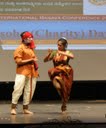Contribute
| Gaana Nritya Saadhana: Service Through Art |
- Suneha Kadimdiwan
07/20/2011
‘Aham Daasami’, I am your ever humble servant. This is the tenet that the great philosopher, thinker and social reformer of 11th century India saint Basaveshwara, lived by. Rooted in the Hindu Vedanta, the idea of service without expecting anything in return, Basaweshwara propagated Daasoha, or the idea of Charity. Of treating all living beings with the dignity and consideration you expect to be given yourself. Basaweshwara founded the Veerashaiva Samaja, members of which community follow this Hindu dharma. The Veerashaiva Samaja of North America (VSNA) convention of 2011 celebrated the First International Daasoha (Charity) day on Monday July 4th, 2011. This event was sponsored by VSNA and presented by Rasarang School of Performing Arts in support of American India Foundation (AIF). Despite being a gorgeous 4th of July day a moderate crowd adorned the aisles of the auditorium to support the cause and the artists on the stage. The afternoon began with the blessings of Swamiji who graced the stage to share few words of wisdom in the form of Basaveshwara vachanas passed down from generations. He explained the importance of Daasoha and the philosophy of Daasoha that Basaveshwara lived by. This was followed by the musical rendition of the vachana, dasarapada and santavani by Pandit Nagaraj Rao Havaldar, the eminent Hindustani singer. As he mesmerized the audience with his resonant yet melodious voice, he took time to point out the similarities in all three different style of devotional poetry. Each one of these poets called a dasa or sant had the same social and spiritual consciousness that lead people to retrospect their own behavior. He was accompanied by his son Kedarnath Havaldar on the Tabla and Dattatreya Velankar on the Harmonium. Moving from Gaana(music) to Nritya(dance) Students from the Rasarang School of Performing Arts under the guidance on their Guru Poornima Risbud started their performance with a beautiful pushpanjali by Aditi Bhivandkar and Deepa Rajamani followed by a Natesha Kauthuvam from the younger students of the school. The students wrapped up the bharatanatyam part of their presentation with a skillfully choreographed number Natanam. Guru Poornima Risbud and Pallavi Nagesha presented high energy folk dance, Koravanji. Koravanjis are fortune tellers in the south Indian tradition. In this rendition, a fortune teller comes to the house of a young girl, who eagerly puts out her hand, only to be told that “Oh beautiful one you will be married to a handsome man, but he will have many other wives, but don’t worry he will leave them all to be with you. Oblivious to the shock of the young maiden, the fortune teller goes on, “Oh and one more thing, while you will have the joys of a loving husband, but you will have troubles of a stern mother–in-law. Hearing this, the young girl, who is so eager in the beginning, starts to cry while the Korvanji carries on jumping to the next home. This was followed by equally energetic number Kamsale, a folk art that comes down as a tradition amongst the devotees of Lord Mahadeshwara. It is a spiritual execution of their “diksha†or religious vow. Traditionally performed by a group of 8 to 12 men playing the Kamsale, or rhythmic clangs, this art form combines dance and martial art movements, set to music that extols the virtues of Lord Mahadeshwara, a manifestation of Lord Shiva. Poornima and Pallavi also presented another folk dance describing a day in the life of a villager. A conversation between a man and his beloved. In a playful mood, the wife personifies her daily chores making him believe that she was out and about with another man. In jealousy, the man asks her who that person is and the explanation leaves him in fits of laughter. Rasarang School concluded their presentation with a beautifully choreographed fusion number Dhimahi, all the dancers moved as one tastefully arranged aquamarine wave to the swaying music. Two other dance schools contributed to the success of this event, Samarthanam School for blind from Bangalore, India and Ettige School of Fine arts. 5 visually challenged students from Samarthanam 2 boys and 3 girls presented 3 pieces. A beautiful piece Natyanjali followed by a solo dance where the dancer danced on a plate carrying a small brass pot on her head. Samarthanam concluded their presentation with a toe tapping kolata, a dance in which the dancer beats 2 beautifully decorated sticks to the rhythmic beat of the song. It was an amazing treat to see the dancers move in unison without missing a single beat or step. Following this performance was another enchanting performance by Ettige school of Fine Arts, of Maryland. Uma Ettige presented Ganesh vandana along with local talents Medha and Sadhika Hiremath. Followed by a unique piece called “Perine†where the dancer performs on top of an upturned decorated clay pot. Uma performed a piece in praise of goddess Shringeri Sharade (Goddess Saraswati of Shringeei, Karnataka). The evening concluded with yet another Gaana part of the day with 2 musical presentations. Dr. Mruthyunjay Shettar presented 2 pieces in Hindustani classical style. Followed by a Basaveshwara Vachana. The grand finale was the vachana, semi classical and film songs by Mrs. Kasturi Shankar the well-known Kannada movie playback singer from golden era. The program was beautifully managed by the emcees Shridhar Kulkarni and Srilakshmi Neergundha.
You may also access this article through our web-site http://www.lokvani.com/









